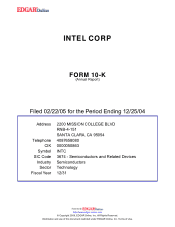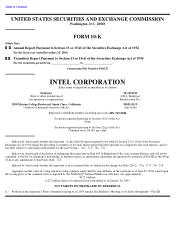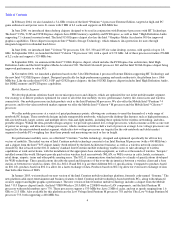Intel 2004 Annual Report Download - page 5
Download and view the complete annual report
Please find page 5 of the 2004 Intel annual report below. You can navigate through the pages in the report by either clicking on the pages listed below, or by using the keyword search tool below to find specific information within the annual report.
Table of Contents
For 2004, the company consisted of two product-line operating segments, the Intel Architecture business and the Intel Communications
Group (ICG). Both of our operating segments use their core competencies in the design and manufacture of integrated circuits, as well as key
silicon and platform capabilities, to provide building blocks for technology solutions. The Intel Architecture business provides advanced
technologies to support the desktop, mobile and enterprise computing market segments. ICG offers products such as flash memory, as well as
platform solutions for the wireless handheld computing and communications market segments. In addition, ICG offers wired and wireless
connectivity products and key networking and communications infrastructure components. In 2004, we combined our communications-related
businesses into a single organization, ICG. Previously, these communications businesses were in two separate product-
line operating segments:
the former Intel Communications Group and the Wireless Communications and Computing Group.
In January 2005, we announced a planned reorganization of our business groups to bring all major product groups in line with the
company’s strategy to drive development of complete technology platforms. These new business units include the Mobility Group, the Digital
Enterprise Group, the Digital Home Group, the Digital Health Group and the Channel Platforms Group. We expect this reorganization to
become effective in 2005. Because the reporting period for this Form 10-K is as of December 25, 2004, the business groups discussed below
and the results of operations for our operating segments in this filing are presented under the organizational structure that existed as of
December 25, 2004.
Intel Architecture Business
The Intel Architecture business develops platform solutions based on our microprocessors, chipsets and motherboard products, which we
optimize for use in the desktop, mobile or server computing market segments. The end-user products into which our products are ultimately
integrated are determined by our customers based on how they choose to meet specific user requirements.
Net revenue for the Intel Architecture operating segment made up approximately 85% of our consolidated net revenue in 2004. Revenue
from sales of microprocessors within the Intel Architecture operating segment represented approximately 72% of consolidated net revenue in
2004. Our microprocessor business generally has followed a seasonal trend; however, there can be no assurance that this trend will continue.
For the past five years, the company’s sales of microprocessors were higher in the second half of the year than in the first half of the year.
Consumer purchases of PCs have been higher in the second half of the year, primarily due to back-to-school and holiday demand. In addition,
technology purchases from businesses have tended to be higher in the second half of the year.
A microprocessor is the central processing unit (CPU) of a computer system. It processes system data and controls other devices in the
system, acting as the “brains” of the computer. One indicator of microprocessor performance is its clock speed, the rate at which its internal
logic operates, which is measured in units of hertz, or cycles processed per second. One megahertz (MHz) equals one million cycles processed
per second, and one gigahertz (GHz) equals one billion cycles processed per second. As computers continue to support increased usage models,
other factors are becoming increasingly important to overall system performance. Examples include the amount of memory storage, the speed
of memory access, the microarchitecture design of the CPU and the speed of communication between the CPU and the chipset. A faster bus,
for example, allows for faster data transfer into and out of the processor, enabling increased performance. A bus carries data between parts of
the system. A common way to categorize microprocessor design architectures is by the number of bits (the smallest unit of information on a
machine) that the processor can handle at one time. Microprocessors currently are designed to process 32 bits or 64 bits of information at one
time. Microprocessors with 64-bit addressing capability can address significantly more memory than 32-bit microprocessors. The Intel
®
Pentium
®
, Intel
®
Celeron
®
and Intel
®
Xeon
™
branded products are based on our 32-bit architecture (IA-32), while Intel
®
Itanium
®
branded
products are based on 64-bit architecture. Another way to provide 64-bit processing capability is for processors based on 32-bit architecture to
have 64-bit address extensions. Certain of our Pentium
®
4 and Intel Xeon products have 64-bit address extensions. The memory stored on a
chip is measured in bytes (8 bits), with 1,024 bytes equaling a kilobyte (KB), 1.049 million bytes equaling a megabyte (MB) and 1.074 billion
bytes equaling a gigabyte (GB). Cache is a memory that can be located directly on the microprocessor, permitting quicker access to frequently
used data and instructions. Some of our microprocessors have additional levels of cache, second-level (L2) cache and third-level (L3) cache, to
offer higher levels of performance.
2


















